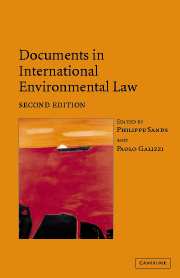Book contents
- Frontmatter
- Contents
- Preface
- PART I General instruments
- PART II Atmosphere
- PART III Oceans: global
- PART IIIB Oceans: regional
- PART IV Freshwater resources
- PART V Biodiversity
- PART VIA Hazardous substances and activities: nuclear
- PART VIB Hazardous substances and activities: pesticides
- 26 Convention on the Prior Informed Consent Procedure for Certain Hazardous Chemicals and Pesticides in International Trade, 10 September 1998
- 27 Convention on Persistent Organic Pollutants, 22 May 2001
- PART VIC Hazardous substances and activities: waste
- PART VII Human rights and the environment
- PART VIII War and the environment
- PART IX Trade and the environment
- PART X Environmental impact assessment and access to information
- PART XI Liability for environmental damage and breaches of environmental obligations
- PART XII The Antarctic
27 - Convention on Persistent Organic Pollutants, 22 May 2001
Published online by Cambridge University Press: 05 June 2012
- Frontmatter
- Contents
- Preface
- PART I General instruments
- PART II Atmosphere
- PART III Oceans: global
- PART IIIB Oceans: regional
- PART IV Freshwater resources
- PART V Biodiversity
- PART VIA Hazardous substances and activities: nuclear
- PART VIB Hazardous substances and activities: pesticides
- 26 Convention on the Prior Informed Consent Procedure for Certain Hazardous Chemicals and Pesticides in International Trade, 10 September 1998
- 27 Convention on Persistent Organic Pollutants, 22 May 2001
- PART VIC Hazardous substances and activities: waste
- PART VII Human rights and the environment
- PART VIII War and the environment
- PART IX Trade and the environment
- PART X Environmental impact assessment and access to information
- PART XI Liability for environmental damage and breaches of environmental obligations
- PART XII The Antarctic
Summary
Editorial note
The 2001 Stockholm Convention on Persistent Organic Pollutants (2001 POPs Convention) aims to protect human health and the environment from persistent organic pollutants, and to that end it imposes measures to reduce or eliminate releases from the production and use of certain POPs (Article 1). The Convention is precautionary in approach, and initially targets 12 POPs: Annex A lists those which are targeted for elimination and Annex B lists those which are to be restricted.
Article 3(1) requires parties to eliminate the production and use of all the chemicals listed in Annex A, in accordance with that Annex, and to restrict production and use of chemicals listed in Annex B. Annexes A and B identify ‘specific exemptions’ in relation to the production and/or use of some but not all of the chemicals, and Annex B additionally identifies certain ‘acceptable purposes’. Article 3(2) requires parties to permit imports of chemicals listed in Annex A or Annex B for the purposes of environmentally sound disposal (in accordance with Article 6(1)(d)) or for a use which is permitted for the importing party under Annex A or B (Article 3(2)(a)). It also requires parties to allow exports only for environmentally sound disposal, or to a party which is permitted to use that chemical under Annex A or B, or to a state which is not a party to the Convention but which has provided an annual certification to the exporting party (Article 3(2)(b)).
- Type
- Chapter
- Information
- Documents in International Environmental Law , pp. 838 - 876Publisher: Cambridge University PressPrint publication year: 2004
- 1
- Cited by



